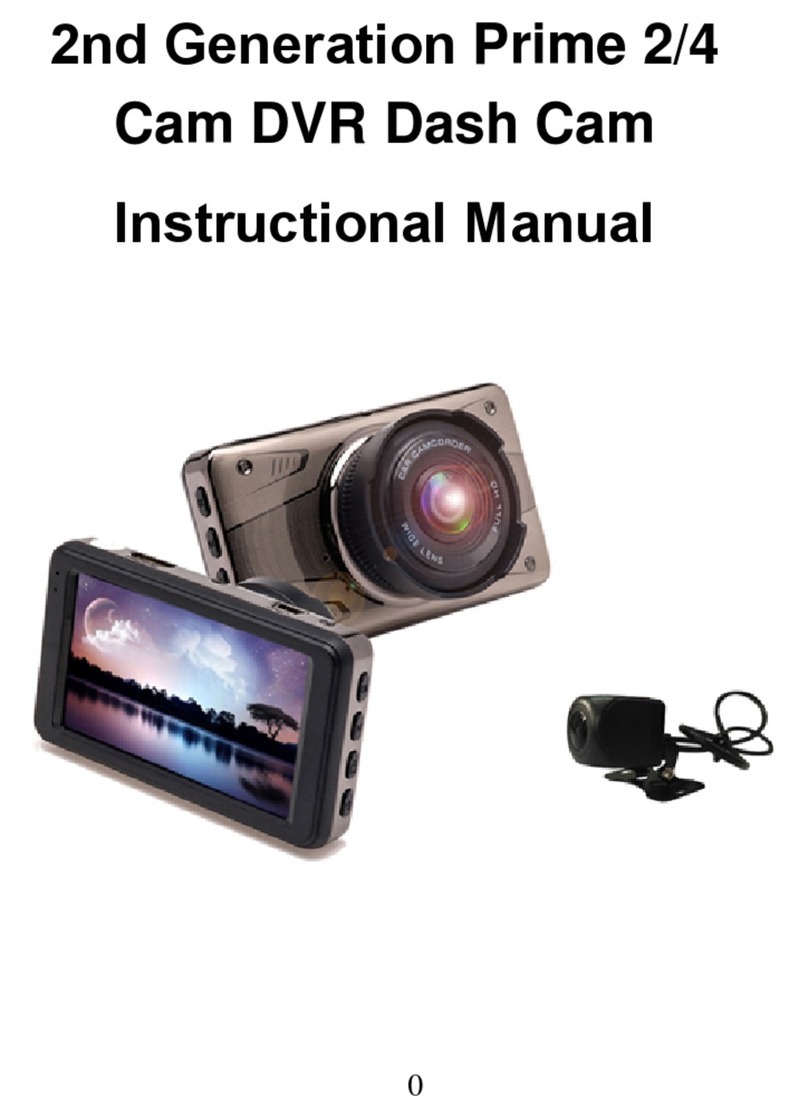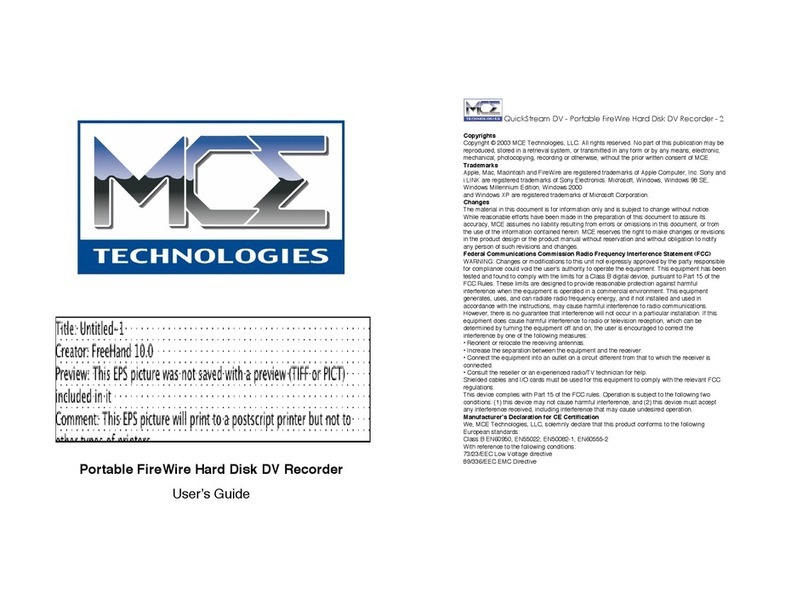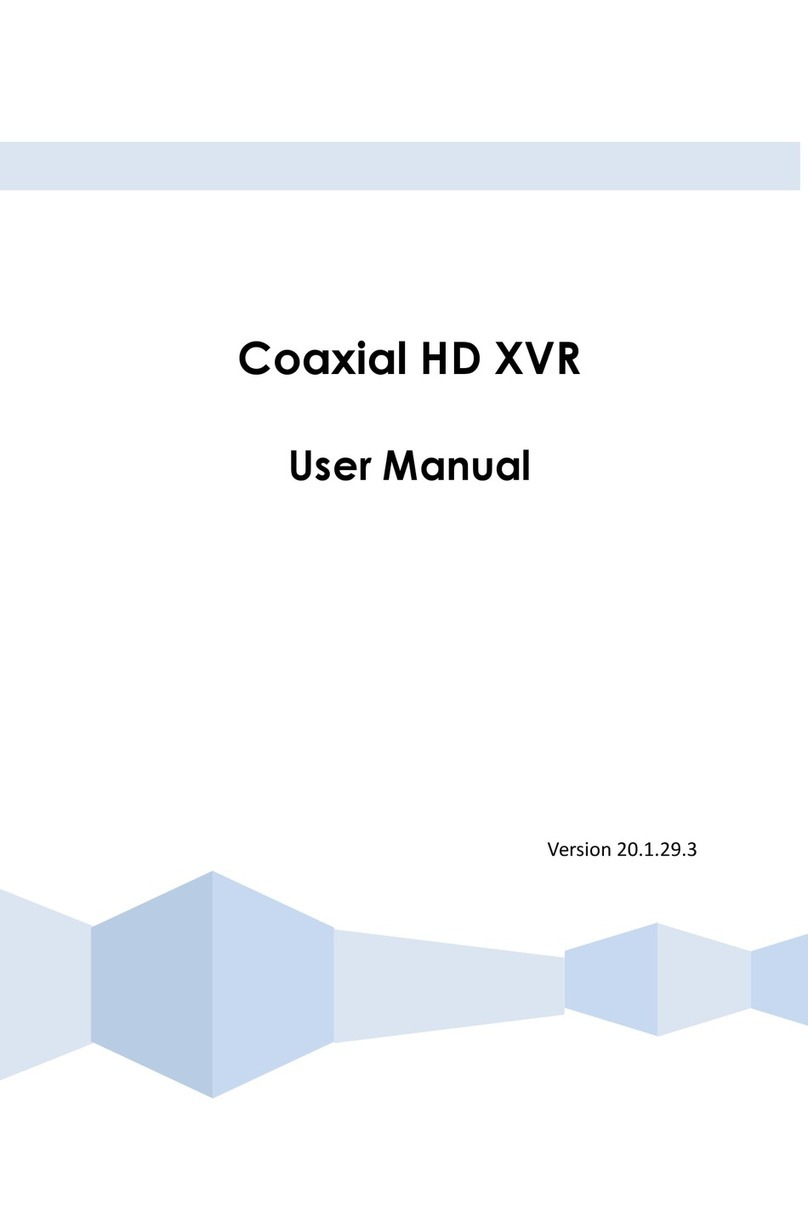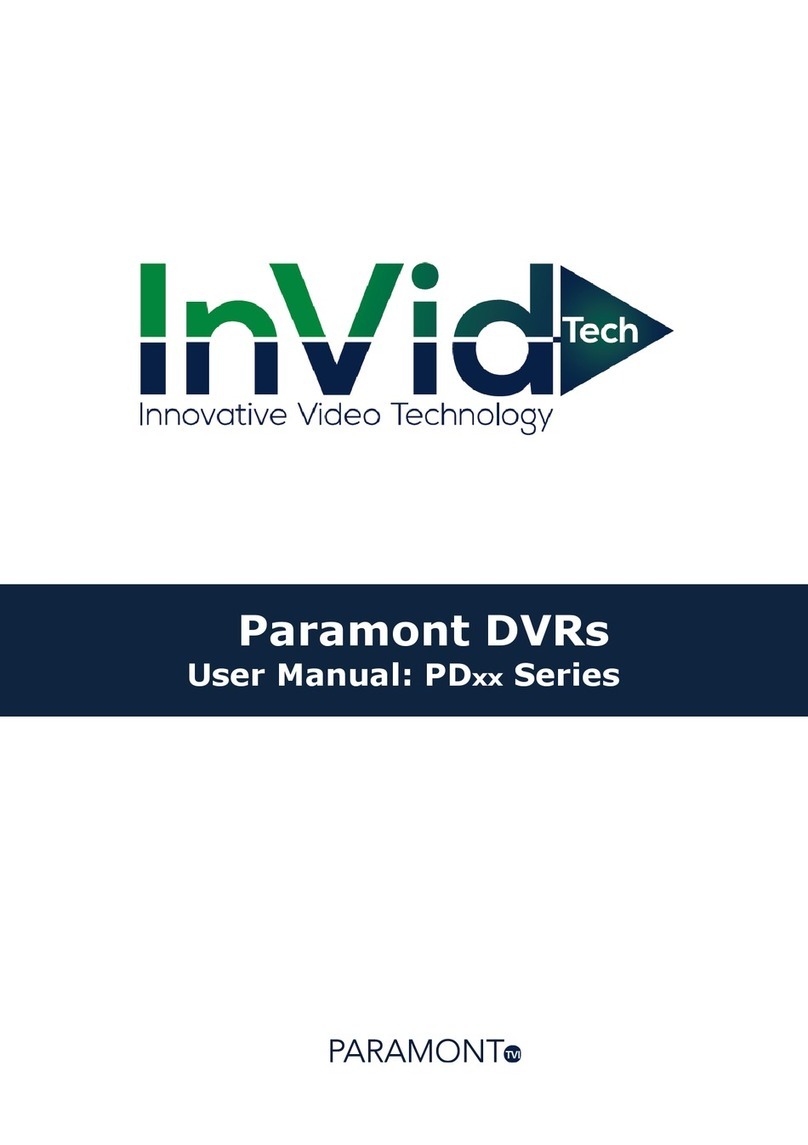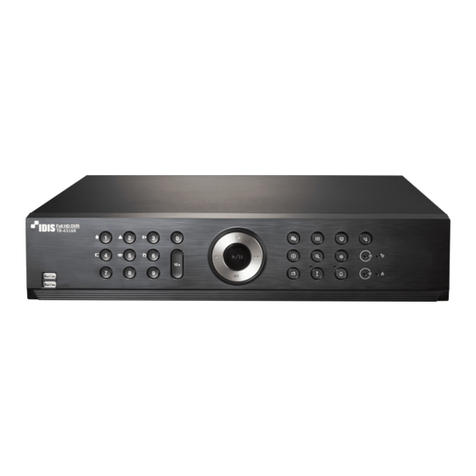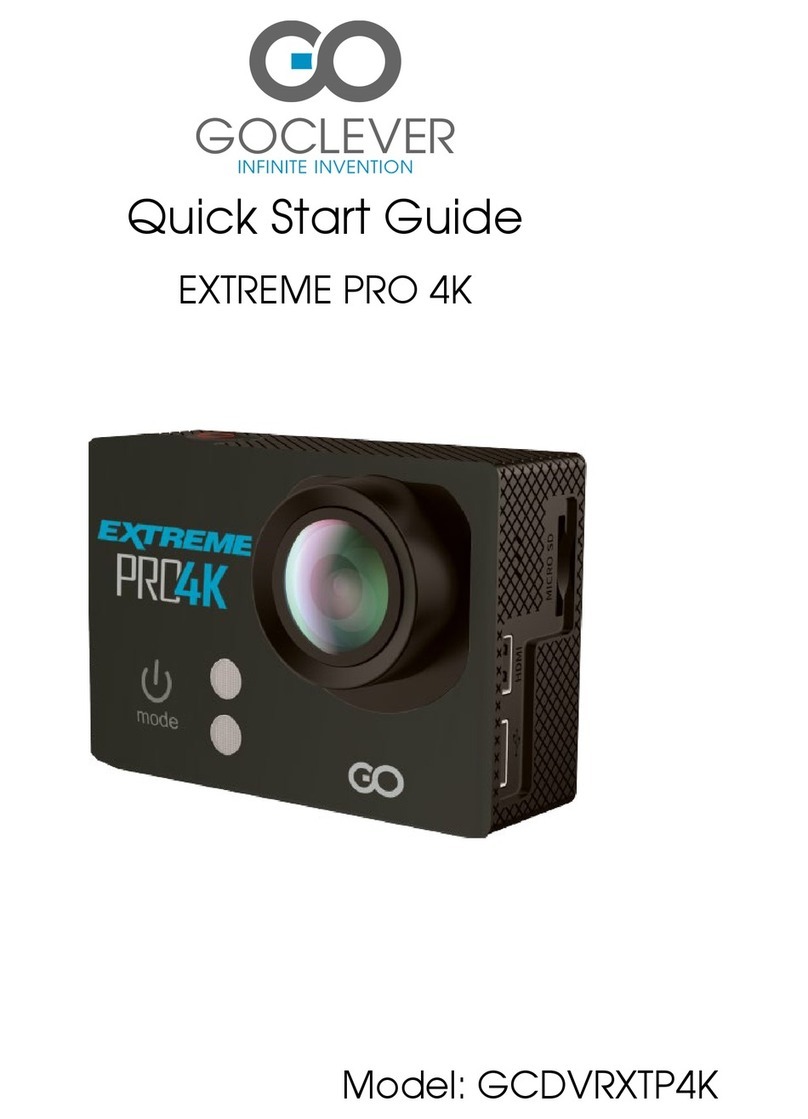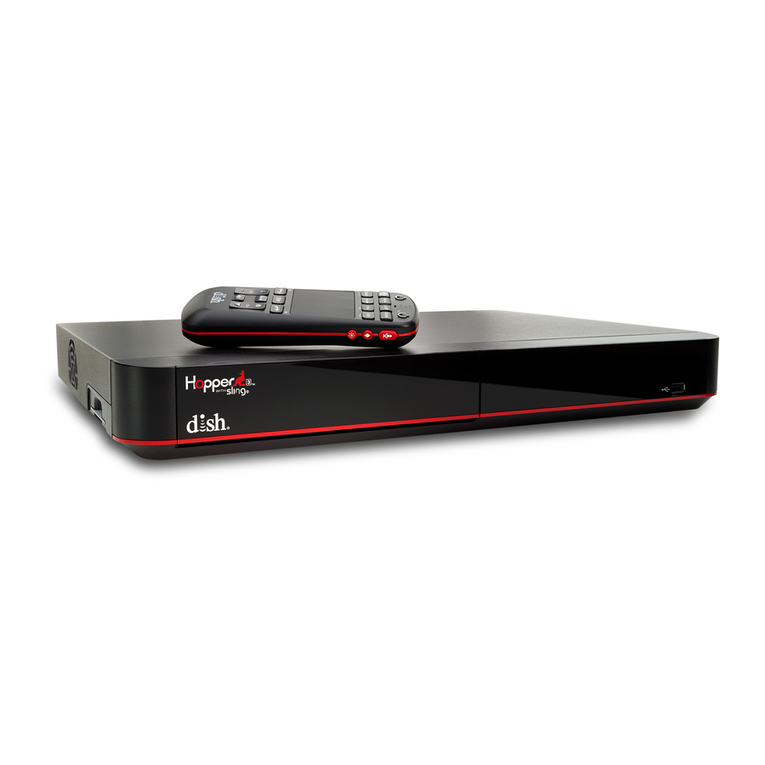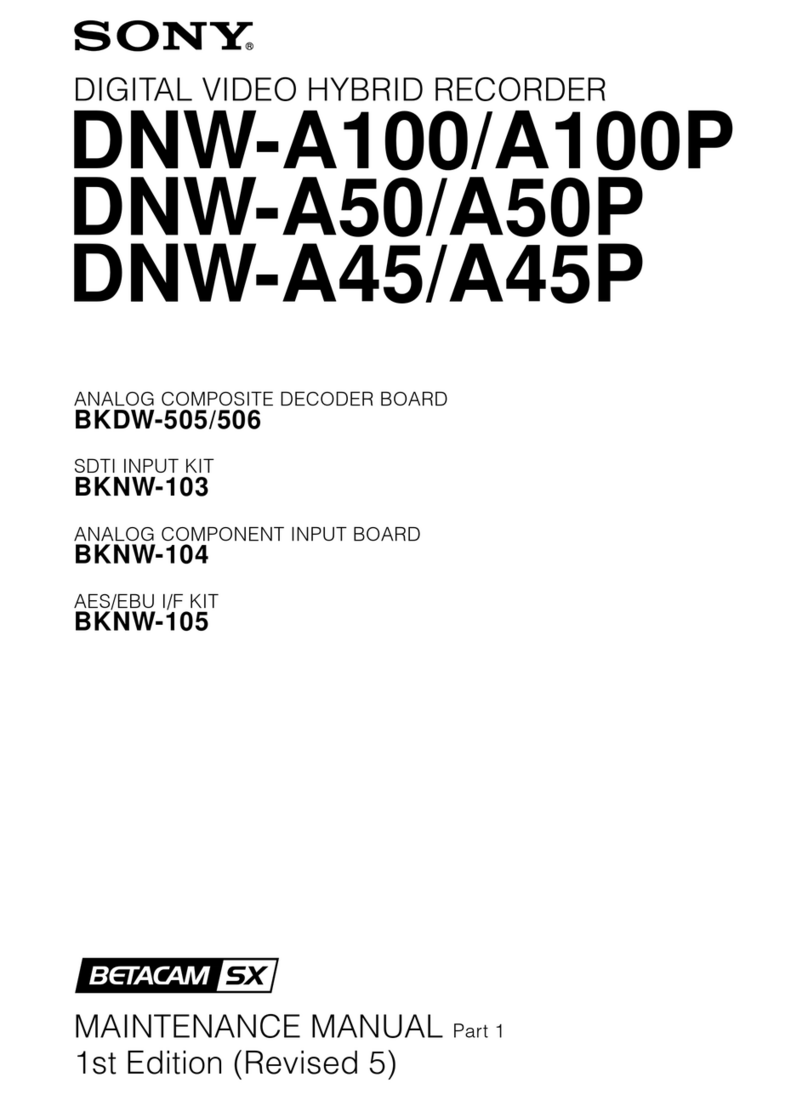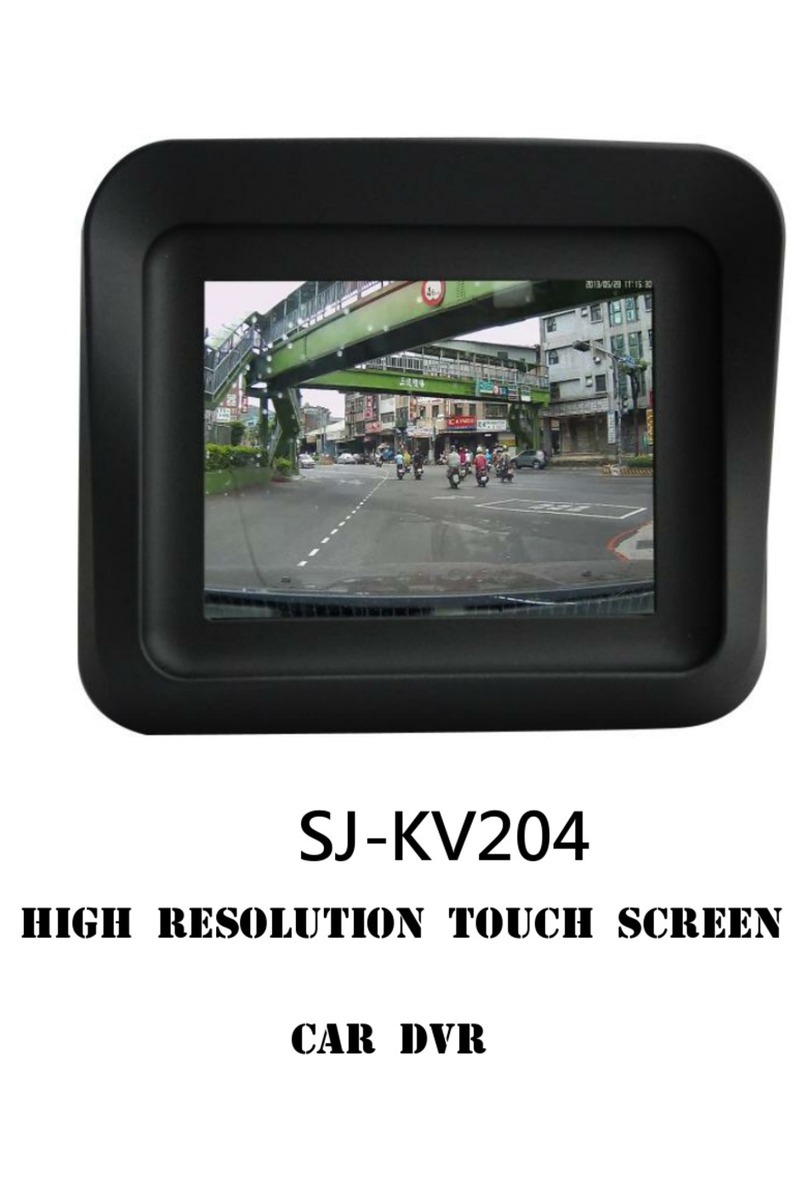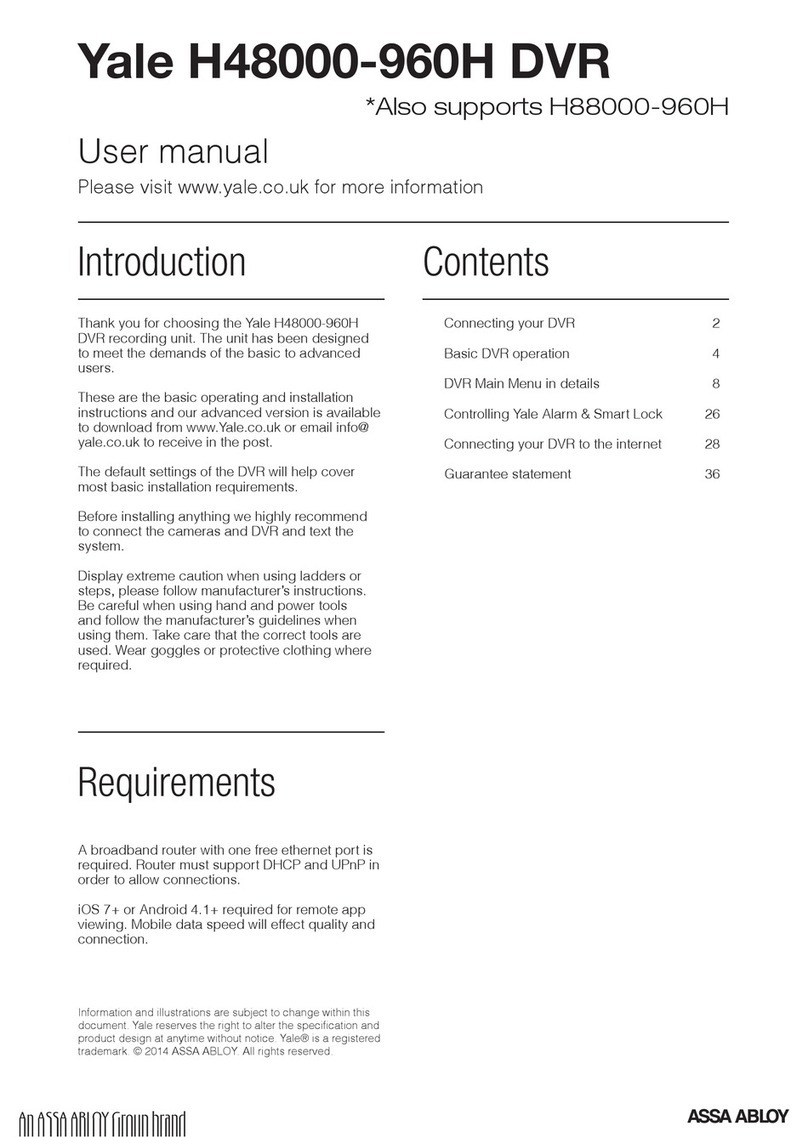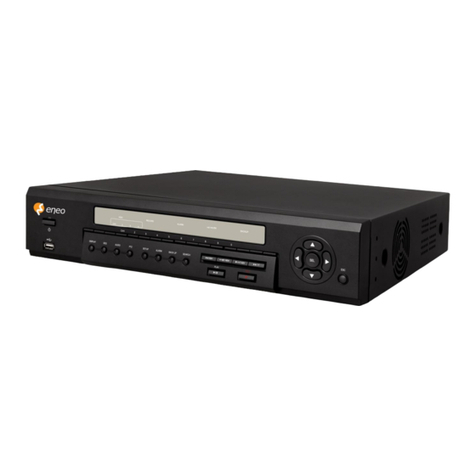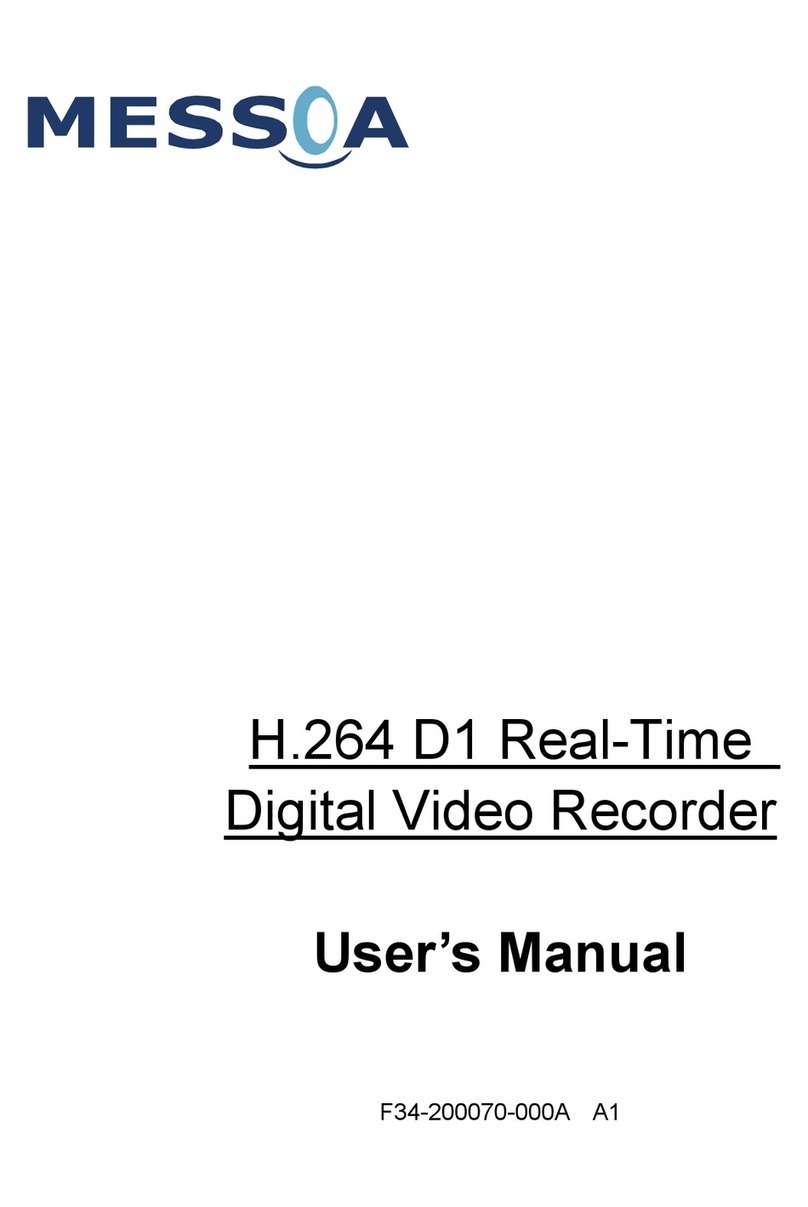Blackmagicdesign HyperDeck Extreme 8K HDR User manual

HyperDeck
Extreme HDR
and HyperDeck Extreme Control
HyperDeck Extreme 8K HDR
HyperDeck Extreme Control
HyperDeck Extreme 4K HDR
June 2023
Installation and Operation Manual

Welcome
Thank you for purchasing your HyperDeck Extreme HDR!
HyperDeck Extreme HDR is a professional video recording deck that records up to 8K
video using H.264, H.265, Apple ProRes and DNx codecs. The unit features a bright and
colorful HDR touchscreen that gives you control via tap and swipe gestures plus displays
scopes for professional SDR and HDR workflows.
You can record up to 8K H.265 on CFast cards or 8K ProRes files via external USB drives
or network storage. Ifyou install the optional cache feature, media speed doesn’t matter
so you can record 8K video to any CFast card or even connect an external HDD dock via
USB-C and record to an external hard drive!
A variety of video and audio sources can be connected including decks, monitors, routers
and cameras, or legacy broadcast decks via composite analog inputs, which is especially
useful for archival workflows converting from tape to file.
We also wanted to create a deck controller that works just like a traditional broadcast
deck with a search dial and familiar controls. With HyperDeck Extreme Control, you can
control your HyperDeck Extreme as well as broadcast decks such as Betacam SP, Digital
Betacam decks and even 1 inch machines. HyperDeck Extreme Control can control up to 8
broadcast decks via industry standard RS-422 connections and we believe you will find the
experience intuitive and efficient!
This instruction manual contains all the information you need to get started with
HyperDeckExtreme and HyperDeck Extreme Control. Please check the support page
at www.blackmagicdesign.com for the latest version of this manual and updates to the
HyperDeck software. Keeping your software up to date will always ensure you get all the
latest features. When downloading software, please register with your information so we
can keep you updated when new software is released. We are constantly working on new
features and improvements, so we would love to hear from you!
Grant Petty
CEO Blackmagic Design
English

Getting Started with HyperDeck
Extreme HDR 5
Plugging in Power 5
Plugging in Video and Audio 6
Plugging in CFast Cards 7
Recording 8
Selecting your Source and Codec 8
Starting Record 9
Playback 10
HyperDeck Extreme Front Panel 11
HyperDeck Extreme Rear Panel 13
Touchscreen Display 17
Touchscreen Features 17
Upper Toolbar 17
Lower Toolbar 24
Settings 28
Dashboard Menu 28
Record 28
Monitor 31
Audio 33
Setup 36
LUTs 44
Entering Metadata 46
Digital Slate 46
Storage Media 51
CFast Cards 51
USB Disk 52
Preparing Media For Recording 53
Preparing Media on a Computer 55
Storage Indicators 57
Connecting to Network Storage 60
Using the Optional Internal Cache 62
Choosing your M.2 NVMe PCIe
Flash Disk 62
Installing The Cache 64
Formatting The Cache 66
Cache Icons and Status 66
Getting Started with HyperDeck
Extreme Control 67
Plugging in Power 67
Connecting HyperDeck Extreme 68
Enabling Remote Control on your
HyperDeck 68
Playback using HyperDeck
Extreme Control 68
HyperDeck Extreme Control Workflow 69
Connecting your RS-422 Devices 69
Connecting your Video Signal 70
Reference Signal 71
Selecting your Devices 71
Controlling your playback
andrecord decks 71
Testing Control 72
Finding your Timecode Point using
the Search Dial 73
Using the Transport Controls 76
Using the Multi Deck Feature 77
HyperDeck Extreme Control Front Panel 78
HyperDeck Extreme Control Rear Panel 79
Blackmagic HyperDeck Setup 80
Using HyperDeck Setup 80
Updating the Internal Software 86
Transferring Files over a Network 87
Accessories 91
Rack Mounting HyperDeck Extreme 91
RS-422 Control 93
Developer Information 100
Blackmagic HyperDeck Ethernet
Protocol 100
HyperDeck Control REST API 117
Notification websocket - 1.0.0 126
Help 131
Regulatory Notices 132
Safety Information 133
Warranty 134
4HyperDeck Extreme HDR and HyperDeck Extreme Control
Contents

Getting Started with
HyperDeck Extreme HDR
This section of the manual shows how to get started using HyperDeck Extreme.
Getting started is as simple as connecting power, plugging in your video and audio, inserting
a formatted CFast card and pressing the record button! You can then stop recording and play
back your files using the built in touchscreen or transport control buttons on the front panel.
However, you can also connect Blackmagic HyperDeck Extreme Control and operate your
HyperDeck remotely. This is a powerful external controller with many features including a
search dial for precise jog and shuttle control. An entire section dedicated to HyperDeck
Extreme Control is provided later in this manual.
Plugging in Power
To power your HyperDeck Extreme, connect a standard IEC cable to the AC power input on
the rear of the unit. You can also use the 12V DC input if you want to connect external power
or redundancy via an external power supply, for example an uninterruptible power supply or
external 12V battery.
Connect power to the AC or DC power inputs on
the rear of HyperDeck Extreme 8K HDR
5Getting Started with HyperDeck Extreme HDR

NOTE When plugging in external power, make sure the power voltage output matches
the input voltage range marked on the rear panel.
Once powered, the touchscreen display will prompt you to select your language. To select your
language, tap on the language option followed by ‘update’. The main window will now appear.
Select your language and tap update to confirm
TIP You can change your language at any time via the setup menu. For more
information, see the ‘setup’ section within settings later in this manual.
Plugging in Video and Audio
There are a range of connectors on the rear of the unit so you can plug in a variety of sources,
from analog composite and component video, to SDI and HDMI.
If you want to connect an HDMI or SDI monitor, plug them into the HDMI or SDI outputs.
Audio is embedded in SDI and HDMI so you don’t have to worry about connecting audio.
However, if you want to plug in analog audio sources you can connect them via the balanced
XLR or unbalanced RCA inputs. For detailed information on all the input and output connectors,
refer to the ‘HyperDeck Extreme rear panel’ section of this manual.
Plug your video source into the SDI, HDMI or analog
video inputs on HyperDeck Extreme 8K HDR
6Getting Started with HyperDeck Extreme HDR

TIP HyperDeck Extreme automatically detects the video format and frame rate and
you can see this information displayed on the touchscreen overlay.
Plugging in CFast Cards
HyperDeck Extreme ships ready to record immediately. All you need is a formatted CFast card!
You can format your CFast cards via the touchscreen LCD or via a computer. For more
information, see the ‘preparing media for recording’ section later in this manual.
Using CFast Cards
The front panel features two CFast 2.0 slots for recording. CFast cards are capable of
supporting very high data rates, so are perfect for recording HD and Ultra HD Apple ProRes.
You can even record up to 8K H.265 files when recording on HyperDeck Extreme 8K HDR.
To insert a CFast card, slide it into the CFast card slot with the smaller socket facing upwards.
Apply gentle pressure until you feel it click into place. If the card is inserted incorrectly, you will
feel a solid resistance and the card will not seat.
Insert the CFast card with the card’s small slot facing upwards
To remove a CFast card, gently push the CFast card into the slot until you feel it click, then
release. The card willeject enough for you to hold the end of the card and remove it from
the slot.
That’s all there is to getting started! With the unit powered, your video source plugged in and
CFast cards formatted and inserted, you can now start recording!
Keep reading this manual to learn about all the record and playback controls on your
HyperDeck and how to change settings using the touchscreen display. You can also find
information about the connectors on the rear panel, including how to connect analog archival
video via the composite and component inputs.
7Getting Started with HyperDeck Extreme HDR

Recording
HyperDeck Extreme records video using H.264, H.265, Apple ProRes and DNx codecs.
The default codec is H.265 so you can press record straight away. Torecord 8K video on
HyperDeck Extreme 8KHDR, you can also change the codec to ProRes LT. This section of the
manual will show you how to do that.
Selecting your Source and Codec
Change the source and codec settings using the intuitive touchscreen display.
To select a source:
1 Tap the ‘source’ icon to the right of the timecode display at the top of the touchscreen to
open the ‘record’ menu.
2 From the input options, tap the icon corresponding to the source input your video signal is
connected to, for example HDMI or component.
To select a codec:
1 From the codec options, tap on H.264, H.265, ProRes or DNxHR.
2 Different quality settings are available depending on the codec selected and you can
choose one by tapping the desired ‘quality’ icon. For ProRes, ‘HQ’ is the highest quality
available. If you have selected H.265, ‘high’ will record the highest quality.
8Recording

To return to the main display, tap the menu icon in the top right corner. Your input and codec
selection will appear on the top toolbar of the main display along with the video source
on the LCD.
TIP For more information on codecs and available quality settings, see the ‘codec and
quality’ section in the record menu later in this manual.
Starting Record
Now that you have set your source and codec, you can start recording.
Press the ‘record’ button on the front panel, or tap the red record icon on the touchscreen.
Youcan see your HyperDeck is recording because the record button will illuminate red
along with the timecode display and media icon. To stop recording, simply press either the
touchscreen or front panel ‘stop’ button.
Media Warning Indicator
If you are recording Ultra HD or high quality 8K video using slower media, you may experience
problems with your media. For example, 8Krecording uses a higher data rate compared to
Ultra HD, so your CFast cards need to be the fastest available. If there are problems with your
media during recording, you will see a red exclamation icon above the audio meters on the
touchscreen overlay.
An exclamation mark will appear in the lower right hand corner of
the display if problems with your media have been detected
9Recording

We strongly recommend making sure your media is on the approved media list, which can be
found in the ‘storage media’ section later in this manual.
Cache Recording
You can avoid the risk of problems with your media completely by using the optional
cache recording feature. This lets you record the highest resolutions and frame rates
on even the slowest media. For example, with a cache you can record 8K ProRes HQ
files onto a CFast card. The optional cache is also important for when recording to
network storage as it ensures your recordings continue even if there are dropouts on
your network.
The optional cache recording feature records all files to an internal M.2 PCIe NVMe
flash disk before they are transferred to your storage media. Depending on the speed
of your storage media, this transfer can appear almost instantaneous! Abenefit of
M.2 PCIe NVMe flash disks is that they are incredibly fast, completely removing the
risk of problems even with slow recording media!
Another benefit of the cache feature is that recordings will continue even after your
connected storage media is full! When the card has no recording space left, the
recording will continue to the cache. Once a formatted CFast card, external USB disk
or network drive is added, the recording will automatically start transferring to the
card or drive.
For more information about cache recording, including how to install the M.2 PCIe
NVMe SSD, see the ‘using the optional internal cache’ section later in this manual.
Playback
Once you have finished recording, simply press the ‘play’ button, or tap the play icon on the
touchscreen to start playback immediately.
You might have noticed that if you press the play button or tap the play icon more than once,
the play icon on the touchscreen changes. That is because pressing play more than once
enables the ‘loop’ feature. Looping can be helpful if you want the playback to continue looping
the same clip indefinitely, or to loop all clips on the timeline.
You can tell which loop feature is enabled by observing the play icon on the touchscreen. Ifitis
not the loop feature you want, simply keep pressing or tapping play to cycle it to the feature
you do want.
Loops the same clip.
After the final clip has played, playback will return to
the first clip and continue playing all clips.
To disable the loop feature, simply tap or press play until the loop icons are no longer visible.
10Playback

Toggle the stop button to switch between playback and record mode
You aren’t locked in to using the soft touch buttons or touchscreen buttons to control
HyperDeck Extreme. Using the HyperDeck Extreme Control you can control your
HyperDeckExtreme and 7other remote devices at once!
For more information on HyperDeck Extreme Control, see the dedicated section later
inthis manual.
HyperDeck Extreme Front Panel
The front panel includes soft touch buttons for easy, immediate access and an ultra bright
2000 nit HDR display to see your video in brilliant true to life colors.
5
2 4
3
1
1 Front Panel Speaker
The built in mono speaker on the front panel lets you check your audio levels directly from
the front panel. Simply tap on the volume meters on the bottom right of the touchscreen
display and adjust the speaker level using the slider.
11HyperDeck Extreme Front Panel

Tap on the audio meters to display and adjust the speaker level
2 Soft Touch Buttons
The front panel features 7 soft touch buttons so you can quickly access traditional transport
controls or apply LUTs. Each button is backlit when the unit is powered so you can easily
see the buttons when the unit is installed in low light conditions, such as a dubbing facility.
If you are using a RS-422 device to control playback and recording remotely, press the
‘rem’ button. This will allow the your HyperDeck to be controlled externally from a device
such as the HyperDeck Extreme Control or the HyperDeck Ethernet Protocol. The button
will illuminate to indicate the remote feature is active. The button will also flash when the
‘identify HyperDeck’ checkbox is selected in HyperDeck Setup.
The five transport control buttons including the most commonly used functions for recording
and playback; record, stop, play, fast forward and rewind. Use these buttons for immediate
control over the record and playback functions.
When active the selected button will illuminate.
3D LUT lets you toggle the active display LUT on the HDR LCD display. The button will
illuminate when active.
For more information on LUTs, including how to set your LUT and display it on the LCD and
or monitor out, see the ‘LUTS’ section later in this manual.
NOTE It is worth noting that if the unit does not have a valid signal connected,
pressing the ‘record’ button has no effect on the unit. This is the same for the play, fast
forward and rewind buttons when no storage mediais connected.
12HyperDeck Extreme Front Panel

3 Headphone Port
Connect a set of headphones to the 1/4” headphone jack on the front panel to listen to
the audio. To change the headphone volume level, tap on the volume meters on the
touchscreen display and adjust the ‘headphone level’ slider.
4 Touchscreen
The 7” LCD display features a large ultra bright HDR video display with intuitive touchscreen
controls. The wide color gamut displays both Rec. 2020 and Rec. 709 color spaces and
100% of the DCI-P3 format. You can also display full screen video scopes. You can access
all available on screen controls and menu options via the touchscreen display!
For more information on the menu settings and using the touchscreen, see the
‘touchscreen display’ section later in this manual.
5 CFast 2.0 Card Slots
2 CFast slots on the front of the panel for your CFast cards. LED lights to the right of the
slotindicate the media status.
Playback
Recording or while cache is transferring
Card is ready or no card is installed
HyperDeck Extreme Rear Panel
6
8
11
12 13 15
16
17
14
7
9
10
Rear connections on HyperDeck Extreme 8K HDR
6 Power
There are two power options on the rear, an AC power input for IEC mains power input as
well as a 12V 4 pin XLR DC input for connecting redundancy or battery power. Ensure any
DC power source connected to the units is compatible with the input voltage and current
rating marked at the DC IN connector
13HyperDeck Extreme Rear Panel

7 Analog Input
Connect analog sources for archiving via the analog stereo left and right RCA connectors,
the single BNC composite input or via the component in.
8 Remote
There are two RS-422 DB9 connectors for remote in and out.
When remote is enabled, you can mirror the transport controls from one HyperDeck to
multiple additional HyperDeck units. Daisy chain your HyperDecks by connecting the
remote out connector from the master HyperDeck to the remote in connector on a second
unit, then continue the RS-422 chain for additional units. When all additional units have
their remote setting enabled, transport controls on the master unit will also control the
additional units.
For example, when you press the ‘record’ button on the master HyperDeck, all the
additional HyperDecks connected will begin recording simultaneously.
9 USB
Use the USB-C connector with the white surround for software updates via a computer
using the HyperDeck Setup Utility.
10 Ethernet
A 10Gb/s Ethernet connection lets you connect directly to your network for recording and
playback with Blackmagic Cloud Store or other network storage. Access media recorded
onto CFast cards or external disk via the web media manager or an FTP client for fast
transfers or control the unit remotely using HyperDeck Ethernet Protocol.
Connect to the same network as an ATEM Switcher and you can use your HyperDeck
for playback using the HyperDecks palette in ATEM Software Control or via an
ATEM broadcast panel. For more details on transferring files via an FTP client, see the
‘transferring files over a network’ section later in this manual.
11 Time Code
Receive external timecode via the XLR timecode inputs or loop out timecode via the XLR
timecode out connection. For more information on how to select your timecode options,
see the ‘setup’ menu later in this manual.
12 Ref
HyperDeck Extreme disk recorders feature a stabilized video reference output
corresponding to standard definition black burst and high definition tri-sync standards.
You can also receive reference signals from external sources such as a sync generator.
This means you can have multiple devices in your facility receiving a reference signal from
a single source, such as the Blackmagic Sync Generator, to genlock all your equipment
together! Select between the input and external reference source via the touchscreen
setup menu.
For more information on selecting your reference source, see ‘setup’ menu later in
the manual.
13 HDMI
The HDMI connections are perfect for when you’re using the unit as a field recorder and
connecting to an HDMI enabled display for playback. For signals from standard definition
to 2160p60, the HDMI input will auto detect SDR and HDR video standards when the signal
is flagged with the correct metadata. This means you can display stunning HDR images on
HDR enabled HDMI screens using the HDMI out.
14HyperDeck Extreme Rear Panel

14 Analog Audio
You can connect up to 4 channels of balanced analog audio in or out via 3 pin XLR
connectors. Select your audio input using the ‘audio’ tab in the dashboard menu. See the
‘audio’ section later in this manual for more information.
15 Monitor Out
A 3G-SDI monitor out connection provides a downscaled output with overlays so that you
can monitor on an external display. The overlays include focus and exposure tools such as
grid and false color that you can toggle on and off as well as drive icons, audio meters and
a time counter display. For more information on the Monitor SDI settings, including how to
output a clean signal, see the ‘monitor’ page in the settings section later in this manual.
16 Ext Disk
Connect a flash disk to the USB-C connector on the rear so you can record to external
disks at up to 10Gb/s. You can also connect to multi port USB-C hubs or the MultiDock 10G
allowing you to connect one or multiple SSDs for far greater storage capacity! Recording to
high speed SSD’s and hard drives reduces the risk of problems with your media compared
to CFast 2.0 cards. For more information on external disks, see the ‘storage media’ section
later in this manual.
17 SDI Digital Video
HyperDeck Extreme features 12G-SDI inputs and outputs on the rear for video signals from
standard definition to Ultra HD via a single cable. Four 12G-SDI inputs and outputs on the
rear of HyperDeck Extreme 8K HDR can be used for 8K30p via dual link 12G-SDI and up to
8K60p via quad link 12G-SDI.
Using the quad link 12G-SDI connections you can use HyperDeck Extreme in 8K workflows.
Connect it to ATEM Constellation 8K as a playback or recording device that can be
accessed via the HyperDecks palette in ATEM Software Control
Connect your 4 12G-SDI cables from the input or output on the HyperDeck Extreme to
one of the 8K inputs or outputs on the rear of the ATEM Constellation 8K. It is important
to connect your quad link SDI cables in the correct order. For example, connect the
SDI input or output labeled ‘c’ on HyperDeck Extreme to the third input or output on the
ATEM Constellation 8K.
15HyperDeck Extreme Rear Panel

Plugging the 8K quad link SDI output of a HyperDeck Extreme 8K HDR into the SDI input of the
ATEM Constellation 8K.
HyperDeck Extreme 8K HDR - Two Sample Interleave
There are two different methods for 8K workflows; two sample interleave and square
division. HyperDeck Extreme 8K HDR and ATEM Constellation 8K both use two
sample interleave, known as 2SI. With 2SI, each 12G-SDI connection delivers an 8K
signal at 1/4 of the resolution. When combined, you have a full resolution 8K signal!
A benefit of the 2SI method is that if one of the 4 connections become loose, you will
only lower the resolution rather than lose one corner of the image, as would be the
case in a square quadrant setup.
AA BB AA BB
CC DD CC DD
AA BB AA
8K
BB
CC DD CC DD
If your 8K workflow involves devices using the square division method, your can use
Teranex Mini SDI to HDMI 8K HDR to convert automatically from 2SI to square division.
16HyperDeck Extreme Rear Panel

Touchscreen Display
Touchscreen Features
The intuitive 7 inch display lets you view and select many of the HyperDeck Extreme functions
directly from the touchscreen display including accessing the menu and storage media.
The interactive touchscreen display lets you view and
select options directly from the screen
The touchscreen display includes an upper and lower toolbar. These toolbars display settings
and status information, for example the current source, or the clip currently being recorded or
played. Settings can also be adjusted by tapping on their relevant icons, for example to change
the source, tap on the ‘source’ icon and then tap on one of the source options.
Indicators show the current status for items such as the source video format and frame rate,
timecode, media record time remaining, audio levels and transport controls.
The lower toolbar can be hidden or revealed by swiping the touchscreen up or down.
Upper Toolbar
Navigate directly to the related menu options by tapping ‘source’ or ‘codec’.
Monitor options
Tap on the monitor icon on the left to access the monitor overlay settings. These settings
let you select and modify the appearance of overlay options including zebra, focus peaking,
guides, grid, false color, contrast, brightness and saturation. This is especially useful when using
the HyperDeck Extreme as a field recorder.
Zebra
Zebra mode will help you to achieve the optimum exposure by displaying diagonal lines over
the areas of content that exceed the set zebra level. To enable zebra mode, toggle the switch to
on. Use the slider or the arrows to the left and right of the percentage icon to select your zebra
level. A level of 100% will mean any area of the image displaying diagonal lines is overexposed.
17Touchscreen Display

Use the slider or arrow to select your zebra percentage
TIP You can also set the zebra to highlight areas of your image that represent specific
video levels on a waveform, for example setting the zebra for 50% means you can
visually identify which regions of your image will appear at approximately 50% on a
waveform scope.
Focus Assist
Focus assist gives you powerful tools to help focus your image fast. Focus assist displays
edge lines on the sharpest areas of the image. To turn on focus assist, toggle the switch to on.
Sensitivity settings let you change how strong the lines are using percentage values. In images
with lots of detail and high contrast, the lines can be distracting, so in these conditions you can
move the slider to between 0% and 50%.
Alternatively, for low contrast shots with less detail, select ‘high’ so the lines are stronger and
easier to see. If you find lines are too visually intrusive, you can select ‘peak’ levels instead.
Formore information on how to set peak levels, see ‘monitor’ settings later in this manual.
18Touchscreen Display

Frame Guides
Guides provide a range of aspect ratios from various film, television and online standards.
Tapthe toggle switch to on and then select your guide by tapping the left and right arrows or
bydragging the slider control.
Grid
The grid option lets you select overlays to assist with shot framing.
Thirds Thirds will overlay two horizontal and two vertical lines over your image, breaking it up
into 9 smaller sections to help you compose your shot. Thehuman eye typically looks
for action near the points where the lines intersect, so it’s helpful to frame key points
of interest in these zones. An actor’s eyeline is commonly framed along the top third of
the screen, soyou can use the top third to guide your framing.
Crosshairs The ‘crosshairs’ setting places a crosshair in the center of the frame. Like thirds, the
crosshairs is a very useful compositional tool, making it easy to frame the subject of a
shot in the very center of a frame. This is sometimes used when filming scenes that will
be assembled using very fast cuts. Keeping viewers’ eyes focused on the center of a
frame can make rapid editing easier to follow.
Center Dot The ‘center dot’ setting places a dot in the center of the frame. This works in exactly
the same way as the ‘crosshair’ setting, albeit with a smaller overlay that you may find
less intrusive.
You can enable a combination of ‘thirds’ and ‘crosshairs’ or ‘thirds’ and ‘center dot’
by tapping both options in the ‘grids’ menu. ‘Crosshairs’ and ‘center dot’ cannot be
selected together.
19Touchscreen Display

False Color
The ‘false color’ setting toggles the appearance of false color exposure assistance on the LCD
touchscreen and the SDI monitor out. When false color is on, different colors are superimposed
over your image to represent different exposure levels. For example, optimal exposure for skin
tones can be achieved by using green for dark shades and pink for light shades. Monitoring
the colors during recording can help you maintain consistent exposure for skin tones.
Similarly, when elements in your image change from yellow to red, that means they are now
over exposed.
TIP Zebra, focus peaking, guides, grid and false color can be toggled on or off via the
‘monitor’ tab in the dashboard menu. You can also toggle the overlays for the 3G-SDI
Monitor output. See ‘monitor’ settings later in this manual for more information.
The three remaining monitor settings alter the LCD display settings.
Contrast Adjust the contrast of the HDR display to increase or decrease the range
between the brightest and darkest parts. A high contrast image can reveal
detail and depth in the image, low contrast can make the image appear soft
and flat.
Brightness Adjust the brightness of the display by dragging the slider to the left to
make the imagedarker, or the right to make it lighter. Changing the display
brightness can make it easier to see images when the HyperDeck Extreme
isin extremely bright or low light locations.
Saturation Use the saturation slider to increase or decrease the amount of color in your
displayed image.
NOTE All settings will be kept when the unit is powered off. It’s also worth mentioning
that the use of monitor options will affect the image displayed on the LCD display,
butnot your recorded video.
20Touchscreen Display
This manual suits for next models
2
Table of contents
Languages:
Other Blackmagicdesign DVR manuals



